The Intel Core i9-9900KS Review: The 5 GHz Consumer Special
by Dr. Ian Cutress on October 31, 2019 10:45 AM ESTCPU Performance: Encoding Tests
With the rise of streaming, vlogs, and video content as a whole, encoding and transcoding tests are becoming ever more important. Not only are more home users and gamers needing to convert video files into something more manageable, for streaming or archival purposes, but the servers that manage the output also manage around data and log files with compression and decompression. Our encoding tasks are focused around these important scenarios, with input from the community for the best implementation of real-world testing.
All of our benchmark results can also be found in our benchmark engine, Bench.
Handbrake 1.1.0: Streaming and Archival Video Transcoding
A popular open source tool, Handbrake is the anything-to-anything video conversion software that a number of people use as a reference point. The danger is always on version numbers and optimization, for example the latest versions of the software can take advantage of AVX-512 and OpenCL to accelerate certain types of transcoding and algorithms. The version we use here is a pure CPU play, with common transcoding variations.
We have split Handbrake up into several tests, using a Logitech C920 1080p60 native webcam recording (essentially a streamer recording), and convert them into two types of streaming formats and one for archival. The output settings used are:
- 720p60 at 6000 kbps constant bit rate, fast setting, high profile
- 1080p60 at 3500 kbps constant bit rate, faster setting, main profile
- 1080p60 HEVC at 3500 kbps variable bit rate, fast setting, main profile
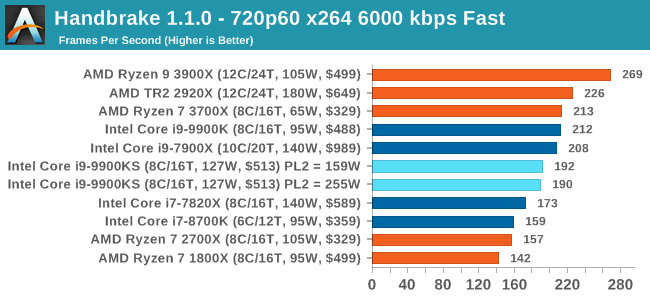
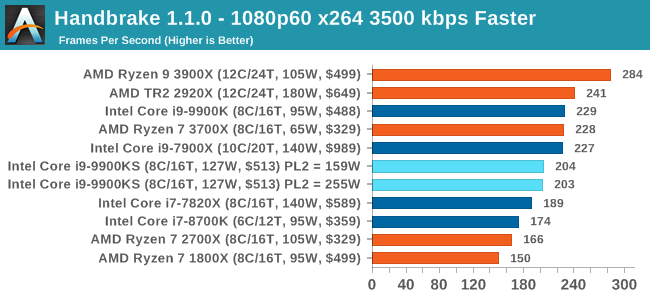
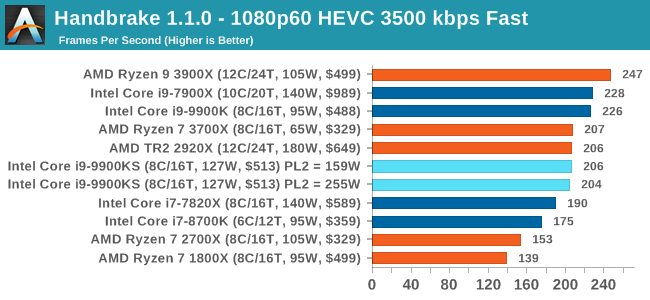
The 9900KS performed worse than our 9900K in our Handbrake tests, and we're not entirely sure why. It might be related to the regression we saw with DigiCortex.
7-zip v1805: Popular Open-Source Encoding Engine
Out of our compression/decompression tool tests, 7-zip is the most requested and comes with a built-in benchmark. For our test suite, we’ve pulled the latest version of the software and we run the benchmark from the command line, reporting the compression, decompression, and a combined score.
It is noted in this benchmark that the latest multi-die processors have very bi-modal performance between compression and decompression, performing well in one and badly in the other. There are also discussions around how the Windows Scheduler is implementing every thread. As we get more results, it will be interesting to see how this plays out.
Please note, if you plan to share out the Compression graph, please include the Decompression one. Otherwise you’re only presenting half a picture.
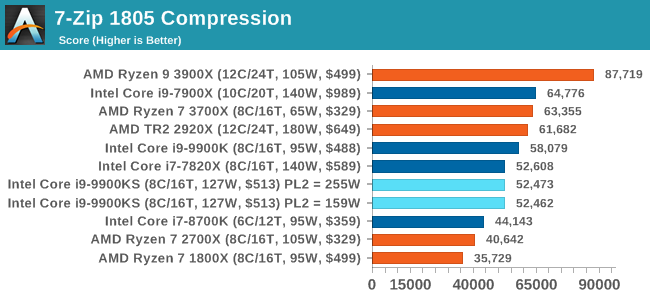
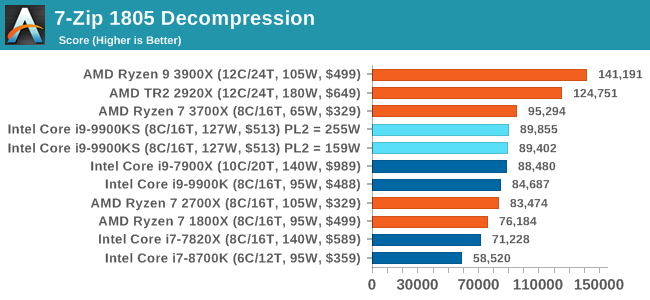
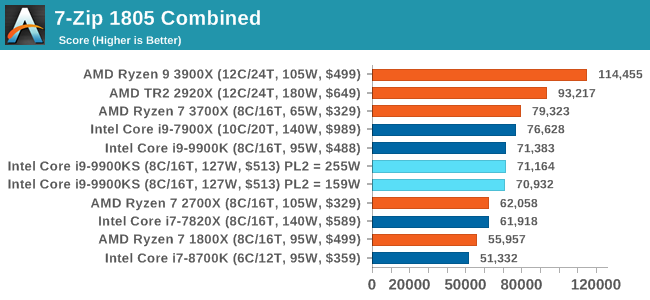
Both the 9900KS settings perform identically here, however the Compression test shows a performance regression compared to the standard 9900K. It does make me wonder if there are additional differences between the two chips (such as an internal clock).
WinRAR 5.60b3: Archiving Tool
My compression tool of choice is often WinRAR, having been one of the first tools a number of my generation used over two decades ago. The interface has not changed much, although the integration with Windows right click commands is always a plus. It has no in-built test, so we run a compression over a set directory containing over thirty 60-second video files and 2000 small web-based files at a normal compression rate.
WinRAR is variable threaded but also susceptible to caching, so in our test we run it 10 times and take the average of the last five, leaving the test purely for raw CPU compute performance.
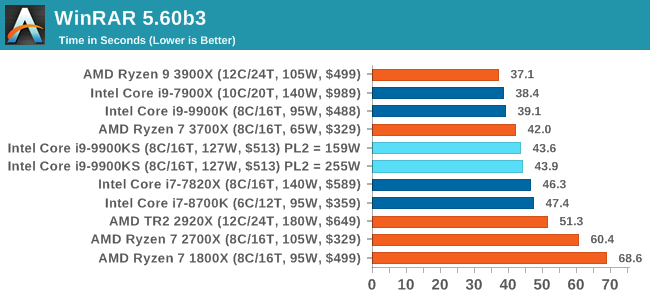
AES Encryption: File Security
A number of platforms, particularly mobile devices, are now offering encryption by default with file systems in order to protect the contents. Windows based devices have these options as well, often applied by BitLocker or third-party software. In our AES encryption test, we used the discontinued TrueCrypt for its built-in benchmark, which tests several encryption algorithms directly in memory.
The data we take for this test is the combined AES encrypt/decrypt performance, measured in gigabytes per second. The software does use AES commands for processors that offer hardware selection, however not AVX-512.
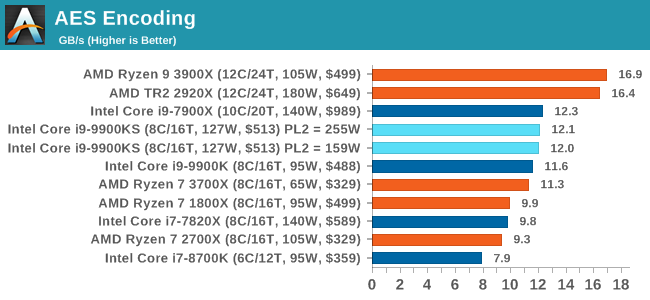










235 Comments
View All Comments
mattkiss - Friday, November 1, 2019 - link
The Processor Specification field in the CPU-Z screen shot has "(ES)" after the cpu name. Did you test and engineering sample or an actual retail sample?GreenReaper - Sunday, November 3, 2019 - link
It was only launched a couple of days ago, so they'd have to have had a sample, you couldn't run the tests and write the article having bought it at retail.BAF2782 - Friday, November 1, 2019 - link
Nice to see a 10+year old Thermalright True Copper: 2kg for a CPU that has a mini-nuclear thermal reactor powering itself. LoL. I can't really say much. I'm using a 11year old ZALMAN CNPS 9900MAX (300watt) AIR cooler on a 5.3GHz Golden 8700K with 1.380v in a z370 Aorus Gaming 7. I thought about getting a new cooler with the $400 open-box 9900K that i just found. But, after seeing the 9900KS running on the 10year old Thermalright True Copper: 2 kg. I don't have a doubt the ZALMAN 9900MAX (300watt) cooler will have any problems running a 5GHz (PO) 9900K.crotach - Saturday, November 2, 2019 - link
So, this is a direct competitor to 2700X, but costs twice as much?I wonder if we'll see intel as a budget offering in a couple of years, cutting the price of their 14nm tech to half of what AMD charges just to get some sales.
My my, how the tables have turned :)
Dragonstongue - Saturday, November 2, 2019 - link
if they can say 4ghs base, but 5ghz all core turbo, why not just have as 5ghz directly ??I confused, seems another marketing ploy of some sort (no real surprise there)
that being said, likely good for AMD as well as sets a new target for them TSMC et al.
Orkiton - Saturday, November 2, 2019 - link
It's like a Caterpillar engine that will need hydrogen fuel to beat most benchmarks. That means expensive Mobo, GPU, PSU, Mem, Cooler, Case.It's Intel stretching to the limits for PR purposes, yet much bellow AMD, in terms of value for money.
liquid_c - Sunday, November 3, 2019 - link
It's unbelievable, i swear. Even Anandtech's comment section has turned into a pcgamer shit show. Instead of just trying to take the article as it is - a piece of info, most of the people here either start a revolution against Intel or just plain dismiss it as "fake information" in regards to TDP. But i see nobody here admitting that Intel's 14nm is ON PAR with AMD's 7nm (i've heard they have the same density but don't quote me on that). Or that said products is not geared towards you or your acquaintances. I swear to God, it's like Intel has raped some family member or something. Just buy whatever you think is fit for you and leave others to enjoy proper journalism (which is so f*cking rare nowadays).liquid_c - Sunday, November 3, 2019 - link
*are not geared.Sigh, i miss an edit button :(
Korguz - Sunday, November 3, 2019 - link
cause it is fake info, 127 watts ?? nope, 200+ more then likely. and some i think, are tired of the lies, BS, and over charging intel has had us pay over the years. face it, if amd didnt bring out zen, the chances are we would still be stuck at quad core for the mainstream, and anything above that, would be HEDT. FYI, it may be on par, but intel should also be on 10nm by now... maybe even the next node size, and yet, intel kept saying, 10nm is on track. there are better, less expensive options then this cpu, this is just intel being intel, last ditch effort to try to save face.The Garden Variety - Sunday, November 3, 2019 - link
Thank you, liquid_c. This needs to be repeated over and over again. You have this stellar quality content, painstakingly researched and presented, and it's clear many of the readers (or at least the ones that comment) are neither understanding it, reading it in context, or even trying to think about it. The smartphone reviews are identical. It's all just "how do I read what I want so I can wage my emotional holy war because I have literally nothing else going for me."Here, I'll go one step further: there's zero reason for a site like Anandtech to have comments following articles at all. You could delete 9 out of 10 attached to this article and zero of value would be lost. Given how terribad the comment system is (no editing, tiny and unscalable input window, spam posts that go undetected for days, etc.) and the effort/investment it would likely take Anandtech's limited team to improve it, just getting the hell rid of it would be a far more sensible solution. Let the content be the star. Send people to the forums in a special board requiring a 500 post barrier in the broader community to contribute to article discussions.